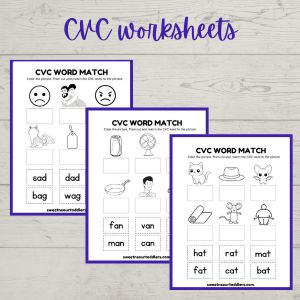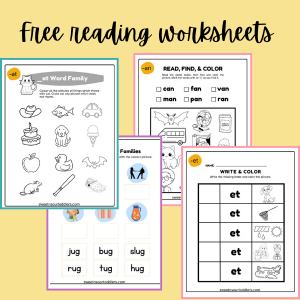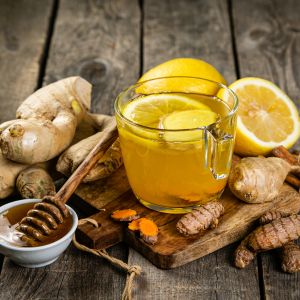One of the most important skills you can teach your child in order to become a terrific reader is to teach them sounds. Mastering the sounds is CRUCIAL to your child’s reading success.
I taught my child to read when she was 2.5 years old (you can read more about that over here). One of the first few things we focused on was mastering sounds.
In this post we’ll discuss the importance of teaching beginning sounds. Then we’ll go over ways you can teach your child beginning sounds in a way thats fun and engaging.
At the end of this post, you can get free download access to some awesome beginning sounds worksheets. Let’s get into it!
Why Teaching Beginning Sounds is Important
This page contains affiliate links. If you choose to purchase after clicking a link, I may receive a commission at no extra cost to you.
- Builds Phonemic Awareness: Phonemic awareness is the ability to hear, identify, and manipulate individual sounds (phonemes) in spoken words. Recognizing beginning sounds is a key component of this skill, which is a strong predictor of future reading success.
- Supports Early Reading Skills: When children can identify the first sounds in words, they can more easily decode words while reading. This skill helps them sound out words and improve their reading fluency.
- Enhances Vocabulary Development: As children learn beginning sounds, they also learn new words and their meanings. This process expands their vocabulary and comprehension skills.
- Facilitates Spelling and Writing: Understanding beginning sounds aids children in spelling and writing. They can use their knowledge of phonemes to spell words phonetically, even if they are not yet perfect spellers.
- Boosts Confidence: Mastering beginning sounds gives children a sense of accomplishment and confidence in their reading abilities. This positive reinforcement encourages them to continue learning and improving.
How to Teach Beginning Sounds
Teaching beginning sounds can be a fun and interactive process. Here are some effective strategies:
1 .Sound Games: Incorporate games that emphasize beginning sounds. For example, you can play a game where you say a sound, and children have to find an object in the room that starts with that sound. Another game could involve sorting pictures based on their beginning sounds.
2. Alphabet Songs and Rhymes: Use songs and rhymes to make learning sounds engaging. Many alphabet songs highlight the initial sounds of letters, making it easier for children to remember.
3. Picture Cards Game: Utilize picture cards to practice beginning sounds. Show a card with a picture (like a cat) and ask the child to identify the initial sound (/c/). This visual aid helps solidify the connection between sounds and words (get access to these picture card games when you sign up below!)
4. Read Aloud: During read-aloud sessions, emphasize the beginning sounds of words. For example, “B is for Bear, B-b-bear.” Encourage children to repeat the sounds after you.
5. Beginning Sounds Worksheets: Use worksheets that focus on beginning sounds. These worksheets often include activities such as matching pictures to their initial sounds, tracing letters, and coloring images that start with specific sounds. Worksheets provide structured practice and can be a great way to reinforce learning (get your beginning sounds worksheets delivered straight to your inbox by signing up below!)
6. Environmental Print: Use print found in the environment, such as signs, labels, and packaging, to teach beginning sounds. Point out familiar words and emphasize their initial sounds.
Here are some games on Amazon that will help your child practice their beginning sounds:
Coogam Wooden Short Vowel Reading Letters
What Letter Do I Start With? Family Board Game
Conclusion
Teaching beginning sounds is a critical step in developing a child’s reading and writing skills. By using a variety of fun and interactive methods, parents and educators can help children master this important skill. The key is to make learning enjoyable and consistent, providing plenty of opportunities for practice and reinforcement. As children become more confident in identifying beginning sounds, they will be better equipped to tackle more complex aspects of literacy, setting the stage for lifelong reading success.

Sign up below – I’ll send you your beginning sounds activity sheets, tons of other totally FREE phonics activity sheets and will also share with you little known secrets to get your child to become a superb reader. This is EXACTLY how I taught my 2.5 year old to read and I’d like to share what I’ve learnt with you too 🙂
Trying to teach your child how to read and feel totally clueless?
When my daughter was two and a half, teaching her to read was the last thing on my mind. Like most toddler parents, I was much too preoccupied with challenges like potty training and managing tantrums.
I stumbled upon Children Learning Reading totally by accident.
I watched in jaw drop amazement videos of kids as kids as young as 2 sounding out words and reading full sentences.
I was so honestly so skeptical about trying it out. My first thought was that my child was way too young to start. My second thought was that it would take too much effort and time and I didn’t have either to spare.
I put aside these limiting thoughts and instead thought: what do I have to lose?
And so I started. I spent 10 minutes a day and much to my amazement, within a few weeks of using Children Learning Reading my child was reading 3 letter words! She soon progressed to reading sentences and then little short stories.
I can not begin to describe the joy you feel when you see your little one confidently finish reading a story by themselves from beginning to end!
She’s 5 now, reads at 3rd grade level and I literally need to ask her to come out of her reading corner!
If you’re interested, you can read my detailed post on how I taught my child to read: what are the things that worked for us, what I learned from the whole process of teaching my child to read and what I’d recommend you to do.
Check out Children Learning Reading and see why 70,000 plus parents have used this reading program (with zero teaching experience) to see some incredible results!
Oh and don’t forget to grab your free beginning sounds reading activities and printables by signing up below!
We think you’ll enjoy reading these posts next:
7 Creative Ways to Teach a Toddler to Love Reading
5 Toddler Pre-Reading Skills and How to Inculcate Them
10 Inspiring Ideas For Setting Up An Insanely Cute Toddler Reading Corner
Children Learning Reading Review – An Honest Opinion From a Mom
Understanding and Teaching CVC Words: A Guide for Educators and Parents





Leave a Reply